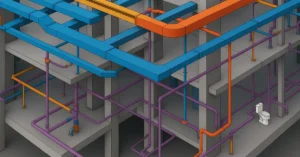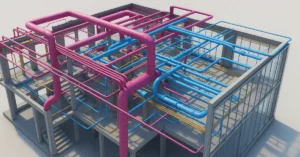How to Design a Skyscraper as an Architect: Unlocking the Blueprint for Iconic Urban Icons

Designing a skyscraper is an architectural feat that demands meticulous planning, innovative thinking, and a deep understanding of engineering principles. As an architect, the opportunity to shape the skyline with a towering structure is both exhilarating and daunting. In this comprehensive guide, we’ll delve into the intricacies of designing a skyscraper, exploring the key considerations, challenges, and best practices involved in bringing these iconic landmarks to life.
Understanding the Essence of Skyscrapers
Skyscrapers are more than just tall buildings; they are symbols of progress, ambition, and urbanization. Understanding the essence of skyscrapers involves delving into their historical evolution, architectural significance, and cultural impact.
Historical Evolution
Skyscrapers have a rich history dating back to the late 19th century when technological advancements such as steel framing and elevators made vertical construction possible. From the iconic Flatiron Building to the modern-day Burj Khalifa, explore the evolution of skyscraper design over the decades.
Architectural Significance
Skyscrapers serve as architectural landmarks that define city skylines and shape urban identities. Their unique designs, innovative engineering, and structural ingenuity make them not only functional but also aesthetically captivating. Dive into the architectural significance of skyscrapers and the role they play in the built environment.
Cultural Impact
Skyscrapers often reflect the aspirations and values of society, serving as symbols of economic prosperity, technological advancement, and urbanization. Analyze the cultural impact of skyscrapers on cities and communities around the world, from New York’s Empire State Building to Dubai’s Burj Khalifa.
Key Considerations in Skyscraper Design
Designing a skyscraper requires careful consideration of various factors, including site selection, structural stability, environmental sustainability, and user experience. Here are some key considerations that architects must address during the design process.
Site Selection
The location of a skyscraper plays a crucial role in its design and functionality. Factors such as site accessibility, zoning regulations, views, and surrounding context must be carefully evaluated when selecting a site for a skyscraper. Explore the importance of site analysis and its impact on skyscraper design.
Structural Stability
Tall buildings face unique structural challenges due to factors such as wind loads, seismic activity, and gravity loads. Architects must work closely with structural engineers to design robust structural systems that ensure the stability and safety of the skyscraper. Learn about different structural systems commonly used in skyscraper design, from steel frames to reinforced concrete cores.
Environmental Sustainability
In an age of increasing environmental awareness, sustainability has become a top priority in skyscraper design. Architects must incorporate green building strategies such as energy-efficient HVAC systems, renewable energy sources, green roofs, and rainwater harvesting to minimize the environmental impact of skyscrapers. Explore the latest trends and innovations in sustainable skyscraper design.
User Experience
Skyscrapers are not just office buildings; they are complex environments that accommodate a diverse range of users, including office workers, residents, and visitors. Architects must design skyscrapers with the user experience in mind, incorporating amenities such as natural light, indoor/outdoor spaces, vertical transportation systems, and flexible floor plans to enhance occupant comfort and well-being.
Challenges in Skyscraper Design
Designing a skyscraper is not without its challenges. From technical constraints to regulatory hurdles, architects must navigate various obstacles throughout the design and construction process. Here are some common challenges faced in skyscraper design and strategies for overcoming them.
Technical Constraints
Tall buildings pose unique technical challenges related to structural stability, wind resistance, and vertical transportation. Architects must collaborate closely with engineers and consultants to address these constraints and ensure the feasibility of their design concepts.
Regulatory Hurdles
Skyscraper projects are subject to stringent building codes, zoning regulations, and permitting requirements. Navigating the regulatory landscape can be complex and time-consuming, requiring architects to stay informed about local building codes and work closely with regulatory authorities to obtain necessary approvals.
Economic Considerations
The cost of designing and constructing a skyscraper can be prohibitive, requiring substantial investment from developers and stakeholders. Architects must balance design aspirations with budget constraints, finding innovative ways to optimize project costs without compromising architectural quality or integrity.
Urban Context
Skyscrapers are integral components of urban landscapes, impacting surrounding neighborhoods, infrastructure, and public spaces. Architects must consider the broader urban context when designing skyscrapers, ensuring compatibility with existing built environments and minimizing adverse effects such as shadowing, wind tunneling, and visual impact.
Best Practices in Skyscraper Design
Despite the challenges, architects have developed innovative strategies and best practices for designing skyscrapers that are not only functional and efficient but also visually striking and socially responsible. Here are some best practices in skyscraper design that architects can incorporate into their projects.
Integrated Design Approach
Successful skyscraper projects require collaboration and integration among architects, engineers, consultants, and stakeholders. Adopting an integrated design approach ensures that all project requirements and objectives are considered holistically, leading to more cohesive and efficient design solutions.
Contextual Sensitivity
Skyscrapers should respond sensitively to their urban context, respecting the scale, character, and heritage of surrounding buildings and neighborhoods. Architects can achieve contextual sensitivity through careful site planning, massing, facade design, and material selection, creating skyscrapers that enhance rather than detract from their surroundings.
Sustainable Strategies
Sustainability is no longer an option but a necessity in skyscraper design. Architects should prioritize energy efficiency, resource conservation, and environmental stewardship throughout the design process, from site selection and building orientation to material selection and operational practices. Incorporating sustainable strategies not only reduces the environmental impact of skyscrapers but also enhances their long-term value and performance.
Human-Centered Design
At the heart of skyscraper design is the human experience. Architects should prioritize occupant comfort, well-being, and productivity by designing spaces that are flexible, adaptable, and responsive to user needs. Incorporating amenities such as daylighting, biophilic elements, outdoor spaces, and wellness programs can create healthier, more enjoyable environments for building occupants.
Case Studies in Skyscraper Design
To illustrate the principles, challenges, and best practices discussed above, let’s examine some notable case studies of skyscraper design from around the world.
1. Burj Khalifa, Dubai
The Burj Khalifa stands as the world’s tallest building, a symbol of Dubai’s ambition and innovation. Designed by Skidmore, Owings & Merrill (SOM), the tower features a sleek, tapered form inspired by Islamic architecture, with a structural system that efficiently resists wind loads and seismic forces. Sustainable features such as high-performance glazing, energy-efficient HVAC systems, and a condensate recovery system contribute to the building’s environmental performance.
2. One World Trade Center, New York
One World Trade Center, also known as the Freedom Tower, is a poignant symbol of resilience and renewal in Lower Manhattan. Designed by Skidmore, Owings & Merrill (SOM), the tower features a crystalline form clad in shimmering glass and aluminum panels, with a symbolic height of 1,776 feet in reference to the year of American independence. The building incorporates state-of-the-art sustainability features, including high-performance curtain wall systems, energy-efficient lighting, and a sophisticated water recycling system.
3. Taipei 101, Taipei
Taipei 101, formerly known as the Taipei World Financial Center, is an iconic skyscraper that dominates the skyline of Taipei, Taiwan. Designed by C.Y. Lee & Partners, the tower features a distinctive pagoda-inspired form with a series of tiered setbacks that evoke traditional Chinese architecture. Structural innovations such as a tuned mass damper system and mega-columns provide stability and resilience against typhoons and earthquakes. The building also incorporates sustainable features such as rainwater harvesting, graywater recycling, and energy-efficient HVAC systems.
Conclusion
Designing a skyscraper is a complex and challenging endeavor that requires creativity, innovation, and technical expertise. By understanding the essence of skyscrapers, addressing key considerations, navigating challenges, and embracing best practices, architects can create iconic landmarks that redefine city skylines, inspire communities, and shape the future of urban living. As stewards of the built environment, architects have the power to transform cities and leave a lasting legacy for generations to come.
If you’re interested in learning more about architecture firms in Europe, check out this comprehensive list of the top 50 firms compiled by Archgyan. From innovative startups to long-established industry leaders, this list has it all. Take a look and discover some of the most inspiring and influential architecture firms in Europe today.
If you’re interested in architecture and want to learn more about this amazing field, subscribe to our podcast on youtube
For more SketchUp tutorials, head to https://www.sketchupguru.com










